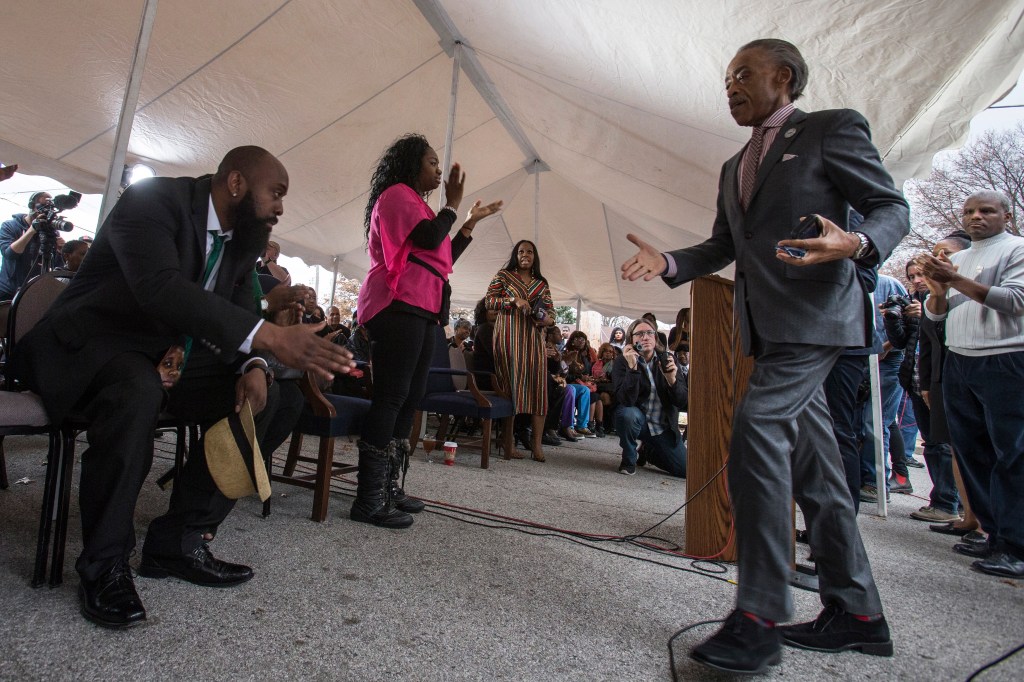FERGUSON, Mo. — On the seventh day they could not exactly rest, but there were signs that residents, protesters, police and business owners were beginning to turn an important corner amid the strife of the past week and the bitter divisions of the past months.
That is not to say the passions and tensions are evaporating on Ferguson’s streets, where plywood covers shattered windows and the National Guard stands vigil after dark over a dozen burned-out shells of small businesses. The looting and destruction came last Monday night, after it was announced that a grand jury would not indict Officer Darren Wilson for fatally shooting Michael Brown, 18, on Aug. 9.
The Rev. Al Sharpton electrified a congregation of several hundred in a St. Louis church with a 50-minute address that was part protest speech, part theological call to action. Brown’s father, Michael Brown Sr., and mother, Lesley McSpadden, sat in the front row.
“You won the first round, Mr. Prosecutor, but don’t cut your gloves off, because the fight is not over,” said the activist preacher and television commentator. “Justice will come to Ferguson!”
Sharpton said the looters and arsonists do not represent “the young folk who are standing up and marching,” and he urged more people, young and old, to join the spreading movement. “They are the true patriots in this country, because they are asking for the system to correct itself.”
Amid Sharpton’s customary fire was the implicit message that the protests are pivoting – “justice” for Brown is at the core, but now it is framed in national and historic terms.
“Ferguson is to this battle what … Selma was to the voting battle,” Sharpton said. Local organizers have vowed that protests will continue indefinitely.
As Sharpton was concluding, at a news conference in Ferguson, Mayor James Knowles was proposing his vision of moving forward, outlining plans for what he said will be one of the first civilian review boards in the region to review complaints and suggestions about police procedures.
Knowles also announced a police explorer program to get students involved with the department, a police academy scholarship program to try to make the largely white force “more reflective of the demographics of our community” and a monthly residential stipend of $300 to entice officers to live in Ferguson.
He also said that Wilson, who resigned from the police force Saturday, does not have a severance agreement for payments or benefits.
After Sharpton’s address and Knowles’s announcements, the center of attention shifted to just outside Ferguson, to a makeshift sanctuary with a pulpit in an auto-loan shop’s parking lot, next to the soot-covered bricks of a small church gutted by fire.
“Even as I inhale, I still smell the smoke,” Pastor Carlton Lee said as he began to address nearly 100 gathered for the service. “But that’s OK.”
Lee, the Brown family pastor, fought tears as he delivered the first sermon since his church building was set ablaze Monday night. It sits a distance from other burned structures, with businesses on either side untouched, leaving Lee to suspect he was targeted for his connection to the Browns. Still, the pastor insisted his congregation must show love.
“Let us hug them,” the pastor said, speculating what he would do if he could confront those who set the fire.
Lee said it is time to pick up the pieces and move forward. “Under pain and adversity, you do not run,” he said as the congregation broke into applause. “We may have took a blow. But we’re not backing down. We’re standing right here.”
Among the signs that this community is beginning to recuperate physically and psychologically is the $50,000 that Lee’s church has been pledged in a crowdfunding campaign via the Web site GoFundMe. In all, hundreds of thousands of dollars have been pledged for several local businesses that were burned, damaged or looted, including $263,000 for Natalie’s Cakes and More on South Florissant Road, according to the GoFundMe site.
The spirit of self-help and mutual aid in the early steps toward recovery are coming even as residents confront hard truths about their community.
Some white residents in the middle-class suburb of 21,000 say they have realized how little they knew about the lives and struggles of some of their black neighbors. About two-thirds of the Ferguson population is African American. Now, during the demonstrations and the cleanup, Fergusonians have been talking to each other across class and race lines.
“I have met so many black people (since Brown was killed) who said this and this and this, and I’m like … ‘I didn’t know that,’ ” said Angelique Kidd, a library assistant who is white. “The treatment by police. The sarcasm” of officers to residents.
“It’s been an unexpected learning experience,” said Darcy Edwin, an artist and teaching assistant who has spent much of the past week painting a mural on the plywood covering a shop where windows were broken. Before, she said, she was too engrossed in her 12-hour workdays to know what was going on in her city.
“You know what has been the biggest difference?” asked Edwin, who also is white. “Being out here.”
Send questions/comments to the editors.



Success. Please wait for the page to reload. If the page does not reload within 5 seconds, please refresh the page.
Enter your email and password to access comments.
Hi, to comment on stories you must . This profile is in addition to your subscription and website login.
Already have a commenting profile? .
Invalid username/password.
Please check your email to confirm and complete your registration.
Only subscribers are eligible to post comments. Please subscribe or login first for digital access. Here’s why.
Use the form below to reset your password. When you've submitted your account email, we will send an email with a reset code.